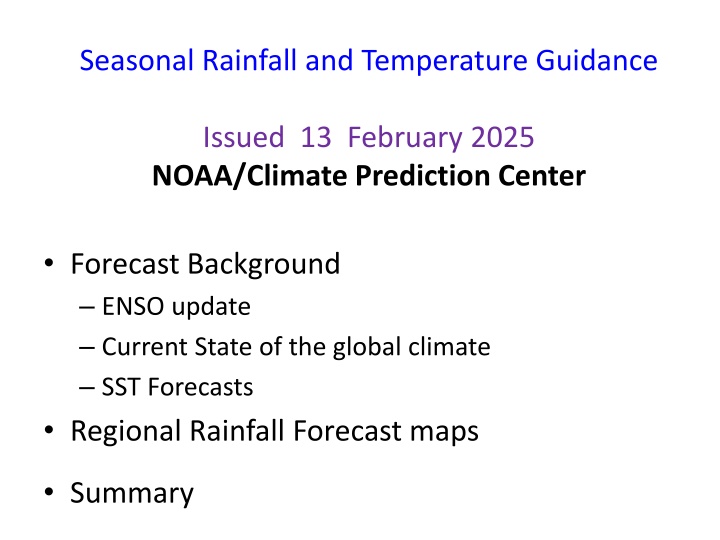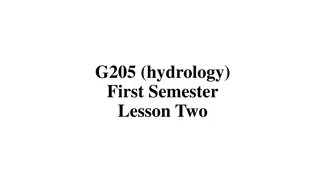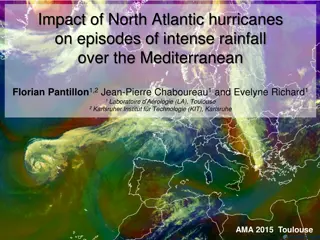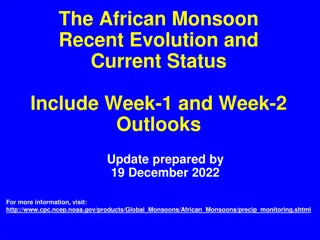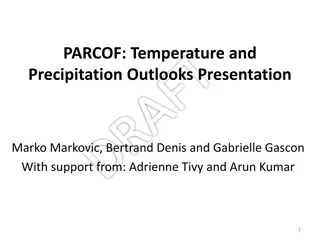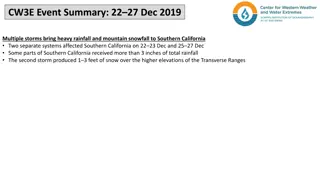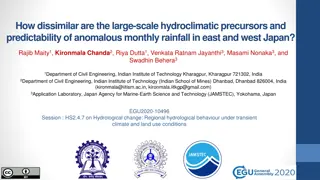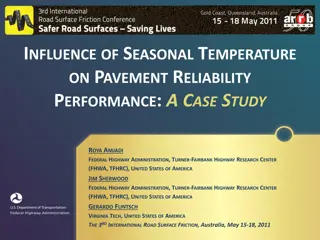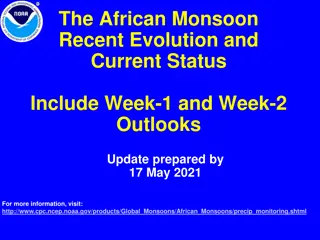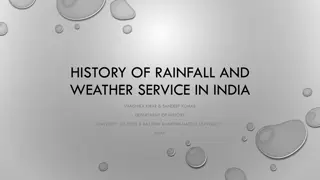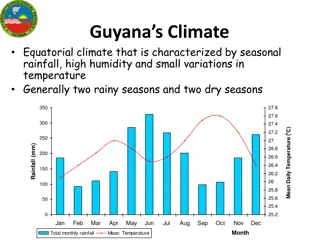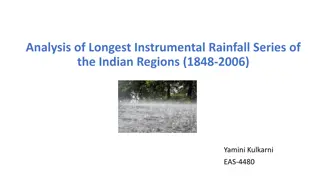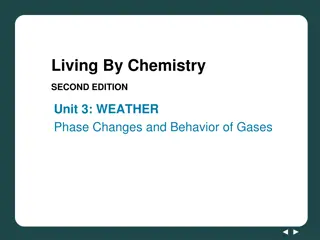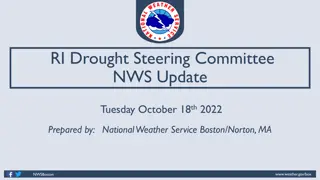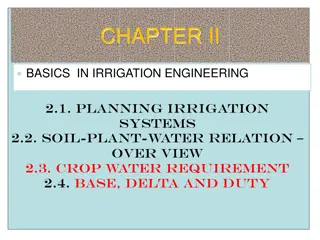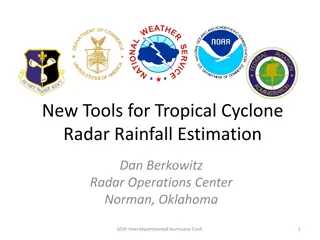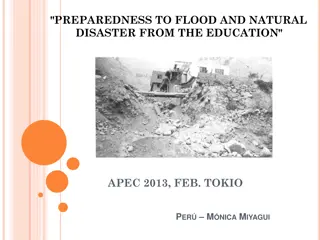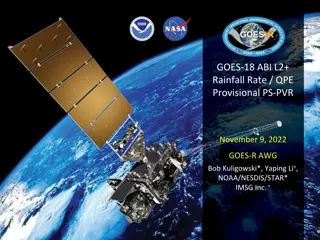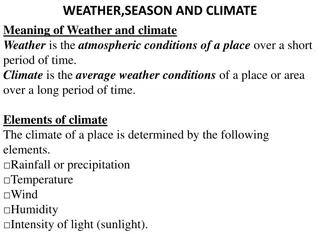Seasonal Rainfall and Temperature Guidance
Issued by NOAA's Climate Prediction Center, the guidance includes ENSO update, global climate state, regional rainfall forecasts, and SST outlooks. La Niña conditions are expected to persist, with a transition to ENSO-neutral likely in March-May 2025.
Download Presentation

Please find below an Image/Link to download the presentation.
The content on the website is provided AS IS for your information and personal use only. It may not be sold, licensed, or shared on other websites without obtaining consent from the author.If you encounter any issues during the download, it is possible that the publisher has removed the file from their server.
You are allowed to download the files provided on this website for personal or commercial use, subject to the condition that they are used lawfully. All files are the property of their respective owners.
The content on the website is provided AS IS for your information and personal use only. It may not be sold, licensed, or shared on other websites without obtaining consent from the author.
E N D
Presentation Transcript
Seasonal Rainfall and Temperature Guidance Issued 13 February 2025 NOAA/Climate Prediction Center Forecast Background ENSO update Current State of the global climate SST Forecasts Regional Rainfall Forecast maps Summary
CPC ENSO Update ENSO Alert System Status: La Ni a Advisory. Synopsis: La Ni a conditions are expected to persist in the near-term, with a transition to ENSO-neutral likely during March-May 2025 (66% chance). (Updated 13 February 2025). http://www.cpc.ncep.noaa.gov/products/analysis_monitoring/enso_advisory/ens odisc.shtml
Summary of State of the Global Climate in January 2025 La Ni a conditions continued in January 2025, as indicated by: Below-average sea surface temperatures (SSTs) across the central and east-central equatorial Pacific Ocean. Below-average subsurface temperatures persisted with below-average temperatures dominating the central and eastern equatorial Pacific Ocean. Low-level wind anomalies remained easterly over the western and central Pacific, while upper-level wind anomalies were westerly over the central Pacific. Convection was suppressed over the Date Line and western Pacific and was enhanced over Indonesia. The traditional and equatorial Southern Oscillation indices were positive. Collectively, the coupled ocean-atmosphere system indicated La Ni a conditions. The Indian Ocean Dipole Index has returned to neutral values in recent weeks. Enhanced convection was observed in parts of Indonesia, northern and eastern Indian Ocean, and Central America. Suppressed convection and precipitation was evident around the Date Line, western Pacific, northern Madagascar, parts of Australia and central South America.
CPC OFFICIAL NIO3.4 Forecast Season La Ni a Neutral El Ni o JFM 95 0 5 FMA 59 0 41 MAM 34 0 66 AMJ 29 1 70 MJJ 27 5 68 JJA 28 12 60 JAS 32 16 52 ASO 35 17 48 SON 36 20 44 La Ni a conditions are expected to persist in the near-term, with a transition to ENSO-neutral likely during March-May 2025.
NINO3.4 Model Forecasts Figure provided by the International Research Institute (IRI) for Climate and Society updated 21 January 2025). - Most models suggest La Ni a will persist through February-April 2025 and then transition to ENSO- neutral. During Northern Hemisphere spring and summer, ENSO-neutral is favored by the dynamical model average and La Ni a is favored to persist by the statistical model average.
NCEP Climate Forecast System version 2 (CFSv2) SST Outlooks (skill masked) (01 08 Feb 2025 IC) Mar - May 2025 Apr - Jun 2025 The NCEP CFSv2 favors below- average SSTs across the central and eastern equatorial Pacific. May - Jul 2025 Jun - Aug 2025
North American Multi-Model Ensemble (NMME) Global SST Outlook (skill masked) (01 08 Feb 2025 IC) Mar - May 2025 Apr - Jun 2025 The SST anomalies in the NMME forecasts are weaker than those in the CFSv2. May - Jul 2025 Jun - Aug 2025
Indian Ocean Dipole (IOD) Outlook NMME forecasts suggest neutral Indian Ocean Dipole (IOD) conditions through the northern hemisphere spring 2025.
Rainfall Guidance, Africa: North American Multi-Model Ensemble (NMME) (01 08 Feb 2025 IC) Sand shade indicates indicate dry climatological mask. White areas show where no one class is dominant: either all terciles are under 36%, or both A and B are over 36% (http://www.cpc.ncep.noaa.gov/products/NMME/NM ME_PROB_descr.html). Mar - May 2025 Apr - Jun 2025 The forecasts call for a slight to moderate tilt in the odds favoring below-average rainfall across the Gulf of Guinea region and the neighboring areas of Central Africa, parts of northeastern Ethiopia, eastern Kenya, southern Somalia, and the southern portion of South Africa. May - Jul 2025 Jun - Aug 2025 In contrast, there is a slight to moderate tilt in the odds favoring above-average rainfall in many parts of the Sahel region, including Sudan and western Ethiopia, as well as parts of the Lake Victoria region. Individual model forecasts can be found here: http://www.cpc.ncep.noaa.gov/products/i nternational/nmme/nmme.shtml
Rainfall Guidance, CAM and Caribbean: North American Multi-Model Ensemble (NMME) (01 08 Feb 2025 IC) Sand shade indicates indicate dry climatological mask. White areas show where no one class is dominant: either all terciles are under 36%, or both A and B are over 36% (http://www.cpc.ncep.noaa.gov/products/NMME/NM ME_PROB_descr.html). Mar - May 2025 Apr - Jun 2025 There is a slight to moderate tilt in the odds favoring above-average rainfall over much of Central America and parts of the Caribbean through the northern hemisphere spring of 2025. There is a slight to moderate tilt in the odds favoring below-average rainfall over much of Central America and Mexico from June to August 2025. May - Jul 2025 Jun - Aug 2025 Individual model forecasts can be found here: http://www.cpc.ncep.noaa.gov/products/i nternational/nmme/nmme.shtml
Rainfall Guidance, Central Asia: North American Multi-Model Ensemble (NMME) (01 08 Feb 2025 IC) Sand shade indicates indicate dry climatological mask. White areas show where no one class is dominant: either all terciles are under 36%, or both A and B are over 36% (http://www.cpc.ncep.noaa.gov/products/NMME/NM ME_PROB_descr.html). Mar - May 2025 Apr - Jun 2025 There is a slight to moderate tilt in the odds favoring below- average rainfall over many parts of Central Asia through the northern hemisphere spring of 2025. May - Jul 2025 Jun - Aug 2025 Individual model and forecasts can be found here: http://www.cpc.ncep.noaa.gov/products/i nternational/nmme/nmme.shtml
Rainfall Guidance, South Asia: North American Multi-Model Ensemble (NMME) (01 08 Feb 2025 IC) Sand shade indicates indicate dry climatological mask. White areas show where no one class is dominant: either all terciles are under 36%, or both A and B are over 36% (http://www.cpc.ncep.noaa.gov/products/NMME/NM ME_PROB_descr.html). Mar - May 2025 Apr - Jun 2025 There is a slight to moderate tilt in the odds favoring below-average rainfall over eastern China. There is a slight to moderate tilt in the odds favoring above-average rainfall over parts of central China, and the far southern areas of South Asia. May - Jul 2025 Jun - Aug 2025 Individual model forecasts can be found here: http://www.cpc.ncep.noaa.gov/products/i nternational/nmme/nmme.shtml
Rainfall Guidance, Maritime Continent: North American Multi-Model Ensemble (NMME) (01 08 Feb 2025 IC) Sand shade indicates indicate dry climatological mask. White areas show where no one class is dominant: either all terciles are under 36%, or both A and B are over 36% (http://www.cpc.ncep.noaa.gov/products/NMME/NM ME_PROB_descr.html). Mar - May 2025 Apr - Jun 2025 The forecasts call for a slight to moderate tilt in the odds favoring above-average rainfall over parts of the Maritime Continent, including parts of Australia. The forecasts call for a slight to moderate tilt in the odds favoring below-average rainfall over parts of Indonesia. May - Jul 2025 Jun - Aug 2025 Individual model forecasts can be found here: http://www.cpc.ncep.noaa.gov/products/i nternational/nmme/nmme.shtml
Rainfall Guidance, South America: North American Multi-Model Ensemble (NMME) (01 08 Feb 2025 IC) Sand shade indicates indicate dry climatological mask. White areas show where no one class is dominant: either all terciles are under 36%, or both A and B are over 36% (http://www.cpc.ncep.noaa.gov/products/NMME/NM ME_PROB_descr.html). Mar - May 2025 Apr - Jun 2025 The forecasts call for a slight to moderate in the odds favoring above-average rainfall over the far northern areas of South America April to June 2025. There is a slight to moderate tilt in the odds favoring below- average rainfall over the far northern, central, and southern parts of South America during the May-to-July and June-to- August seasons. May - Jul 2025 Jun - Aug 2025 Individual model forecasts can be found here: http://www.cpc.ncep.noaa.gov/products/i nternational/nmme/nmme.shtml
Air Temperature Guidance: North American Multi-Model Ensemble (NMME) (01 08 Feb 2025 IC) Mar - May 2025 Apr - Jun 2025 May - Jul 2025 Jun - Aug 2025 The forecasts call for a moderate to high tilt in the odds to favor above-average temperatures over much of the Globe. Individual model forecasts can be found here: http://www.cpc.ncep.noaa.gov/products/international/nmme/nmme.shtml
Summary La Ni a conditions are expected to persist in the near-term, with a transition to ENSO-neutral likely during March-May 2025 (66% chance). NMME forecasts indicate an increased chance for neutral IOD through the NH spring 2025. The NMME forecasts favor a slight to moderate chance for above-average rainfall over parts of the Sahel region including Sudan and western Ethiopia, parts of Central America, northwestern South America, and parts of the Maritime Continent region through the northern hemisphere spring of 2025. The forecasts call for an increased chance for below-average rainfall over many parts of Central Asia, the Gulf of Guinea region and parts of Central Africa, and northeastern and central South America. There is a moderate to high chance for temperatures to trend upward across much of the Globe. Additional forecast resources can be found here: http://www.cpc.ncep.noaa.gov/products/international/index.shtml http://www.cpc.ncep.noaa.gov/products/international/nmme/nmme.shtml http://origin.cpc.ncep.noaa.gov/products/people/wwang/cfsv2fcst/
